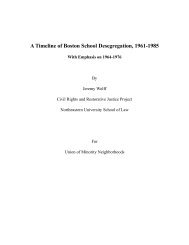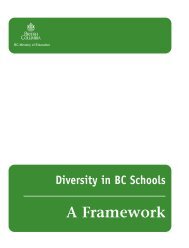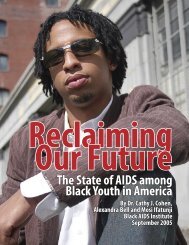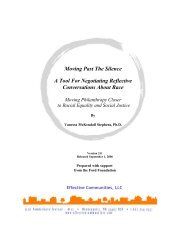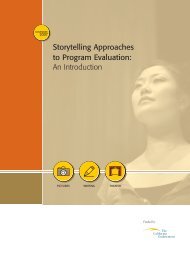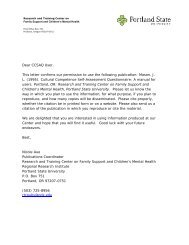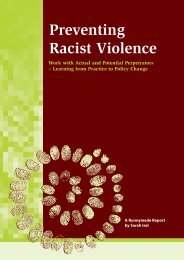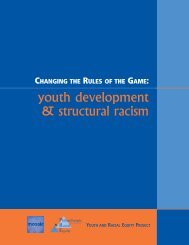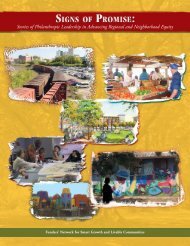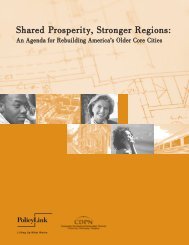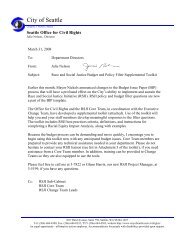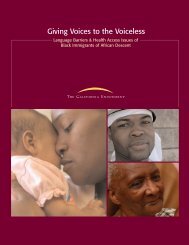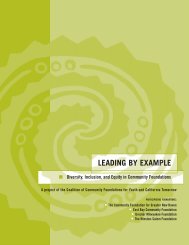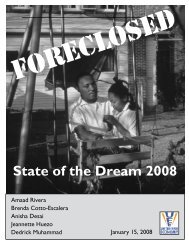lessons learned about civic participation among immigrants
lessons learned about civic participation among immigrants
lessons learned about civic participation among immigrants
Create successful ePaper yourself
Turn your PDF publications into a flip-book with our unique Google optimized e-Paper software.
2000. Efforts to increase the involvement of <strong>immigrants</strong> in schools, neighborhood or blockassociations, and community building projects have been less successful because (1) they havenot been able to help <strong>immigrants</strong> make the connection between their <strong>participation</strong> in theseinstitutions and political power, and (2) they have not helped <strong>immigrants</strong> link these institutions totheir corresponding structures in their countries of origin (e.g., family- or clan-based associationsin China, construction of small bridges in Sudan).Participation of <strong>immigrants</strong> in their own communities. The definition of <strong>civic</strong><strong>participation</strong> has to be made clear. According to the definitions used by the immigrant leaders,members of their communities are participating in <strong>civic</strong> matters within their own groups, but notin mainstream American affairs and institutions. For example, helping one’s neighbor isconsidered <strong>civic</strong> <strong>participation</strong>. Immigrants participate through their own traditional socialorganization 4 and the structures (e.g., informal and formal organizations) that support theorganization. These forms of organization and structure may or may not be compatible tomainstream norms and values in the United States. Where there is compatibility, it is easier toattract <strong>immigrants</strong> to participate in the mainstream <strong>civic</strong> institutions. Where there is nocompatibility, it is essential to build on the traditional organization and structures rather thanimpose new and familiar ideas.Immigrant and mainstream American <strong>civic</strong> structures overlap. The structures utilizedby <strong>immigrants</strong> and mainstream American communities to support <strong>civic</strong> engagement overlap attimes. For example, some <strong>immigrants</strong> use public school facilities to conduct their cultural andlanguage programs, which may or may not be open to members outside of their community. Thetheories of cultural pluralists, pro-assimilation theorists, and integrationists 5 have not fullyrecognized this overlap which increases the likelihood for interaction between immigrant andmainstream leaders and institutions. Likewise, these theorists have not demonstrated how we cantake advantage of this overlay to increase the <strong>participation</strong> of <strong>immigrants</strong> in mainstreamAmerican institutions. This lesson suggests also that the areas of overlay will become denser asthe number and diversity of <strong>immigrants</strong> increase and their <strong>civic</strong> structures multiply and expand,which further emphasizes the need for more knowledge and a focus on the link between cultureand <strong>civic</strong> <strong>participation</strong>. Finally, an immigrant group’s movement toward more <strong>participation</strong> inmainstream American institutions cannot be thought of as a linear or an either-or process. It is agradual process and <strong>immigrants</strong> can participate at different levels to varying extent depending ontheir degree of integration into their new home (c.f. Portes & Zhou, 1994).4 Social organization is defined as a network of relationships that preserve the community’s cultural traditions andvalues.5 These terms have specific meanings <strong>among</strong> theorists and practitioners in the immigration field. Cultural pluralistsexpect to maintain the cultural traditions and values of an immigrant group and, at the same time, expect the group’smembers to cooperate with other groups at the political, economic, and <strong>civic</strong> levels (Gordon, 1964). “Assimilation”meant that <strong>immigrants</strong> should learn English, adopt America’s democratic and egalitarian principles, and live by a setof ethics that require them to become fully “Americanized” (Salins, 1997). The integration model is grounded on amore gradual, mutual, and natural process of adaptation between <strong>immigrants</strong> and the American society (Fix &Zimmerman, 2000).Association for the Study and Development of CommunityMarch 200210



